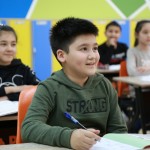I hate the phrase learning loss and I refuse to use it. I don’t believe students “lost” learning or their ability to learn. What I do believe is that two years of learning during a pandemic has created a situation in which students are not practicing learning strategies they once used on a regular basis. Therefore, they are a little rusty with certain skills.
An example of this at my school is meaningful academic discussions among students. Pre-pandemic my school spent several years implementing, developing, and refining the academic conversations strategy. By 2020 our students had become fairly adept. Visitors to our campus took note of the types of conversations our students engaged in and observed that it was evident we had prioritized the strategy campus wide.
Despite that, this school year has shown a notable decline in the quality of academic conversations within our classrooms. This is concerning because I know the power of meaningful student discourse on academic achievement.
Using student observations along with analysis and reflection on the past two years, I’ve determined some causes for the decline and solutions moving forward.
Cause: Inconsistent learningModels
We spent five quarters alternating between online learning and in-person learning. Unfortunately, because of this inconsistency, many practices and routines were interrupted. Academic conversations was one of them. As much as we tried to continue the practice via Zoom, the routine didn’t translate as we hoped. Like any good habit, once it ceased to be practiced, the skill lost sophistication and automaticity.
Solution: As educators we need to re-establish the habit. This means purposefully planning lessons that include academic conversations. This needs to happen frequently because the best way to build a habit is through frequency and repetition. Lessons should be extremely specific to include the point in the lesson in which the conversation will occur, the task on which the conversation will focus, and the desired outcome of the conversation.
Cause: Physical distancing
For the last year and a half, we have kept students three feet apart to reduce the spread of COVID. The days of small groups of students huddled in a tight circle discussing a math problem or piece of text have been absent for a while. While it was a necessary mitigation strategy, it did make student discussions much more challenging. It’s difficult to have a meaningful discussion with someone who is sitting several feet away from you, particularly if your discussion revolves around a shared problem or task.
Luckily, cases of COVID have drastically reduced over the last month. However, some educators are still hesitant to immediately return to pre-pandemic style group work (and rightfully so). We have had our optimism crushed before when a decline in numbers was quickly followed by another surge.
Solution: Start small
We can begin easing back into academic conversations slowly. Beginning with partners (rather than groups) is an effective way to reintroduce academic conversations. Having the conversations last for shorter periods of time is also a viable option. An excellent starting point would be having partners engage in an academic conversation for 10 minutes. We can build from that foundation.
Cause: Over-reliance on devices
When we went virtual in March 2020, we sent a device home with every student. Out of necessity, teachers quickly learned how to deliver instruction and assign learning tasks in a virtual classroom. They became skilled with online platforms that would allow students to do work on a digital space. Once we returned to in-person learning, many teachers continued to use these platforms. It’s totally understandable. They invested valuable time and effort into learning how to use them. The online component also saves time (no making copies or shuffling through student work). Many of the tools will even grade for us.
But here is what I’ve observed with the continued use of the digital tools: they promote independent work. It’s harder for students to collaborate and talk when they don’t have a shared task in front of them. Further, it also lends itself to distraction. I cannot tell you how many times I walk behind students and they are on YouTube instead of doing their assignment.
Solution: Take a break from technology
Don’t get me wrong, I love technology and the opportunities it brings to the learning environment. However, I would like to see teachers use it more as a supplement than an automatic go-to. Deep and rich discussion often needs to be centered on a shared task that both students have in front of them. It provides focus and purpose for the conversation. While our students are re-learning how to engage in academic talk, let’s remove some of the distractions so they can truly concentrate on the conversation.
I know the students at my school are still capable of the rich academic conversations they were having two years ago. They haven’t lost the ability; they are just out of practice. As teachers, we need to provide them the opportunity to practice.
Photo by Mary Taylor on Pexels










Comments 1
So much technology. I try to use our district iPads when they have a purpose, but even then, kids forget and it’s either let them use their phone instead or miss out on the learning. When I agree to the phones, I watch the back and forth between texts, snapchat, and tik tok. It really is the worse it’s ever been with high schoolers and their devices.